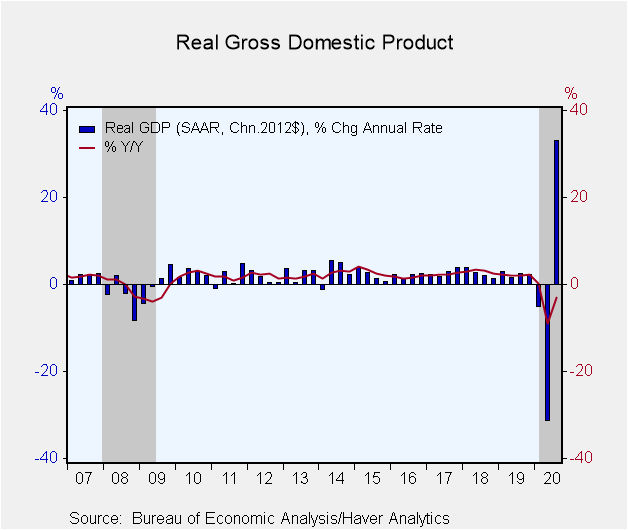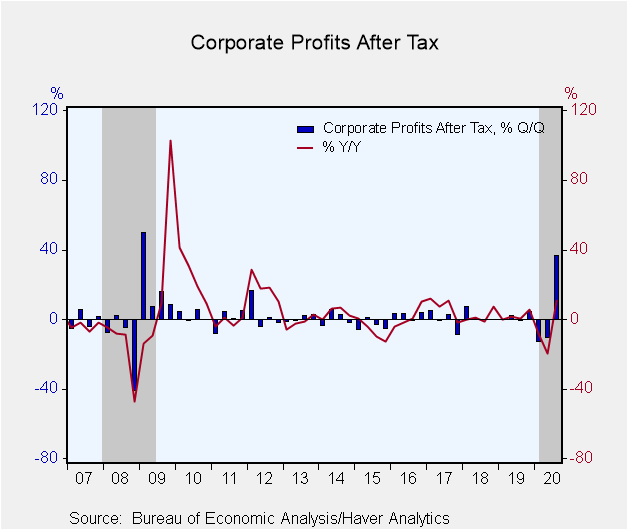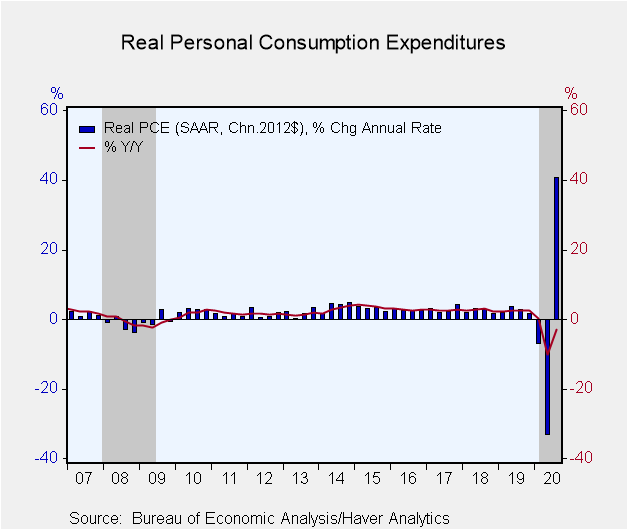 Global| Nov 25 2020
Global| Nov 25 2020U.S. Q3 Growth GDP Unrevised at 33.1%; Corporate Profits Rebound
Summary
• Q3 GDP jumps at an unrevised 33.1% annual rate in second estimate. • Component revisions were relatively small and offsetting. • Q3 after-tax corporate profits rebounds 36.6% non-annualized; above 2019Q4 peak. • Key price measures [...]
• Q3 GDP jumps at an unrevised 33.1% annual rate in second estimate.
• Component revisions were relatively small and offsetting.
• Q3 after-tax corporate profits rebounds 36.6% non-annualized; above 2019Q4 peak.
• Key price measures same as advance estimates.
The second estimate of Q3 U.S. real GDP indicated that economic activity rose an unrevised 33.1% quarter-over-quarter at a seasonally adjusted annual rate (saar). This is the largest quarterly increase on record dating back to 1947. The Action Economics Forecast survey had looked for a 33.2% rise. In combination with the 5.0% saar decline in Q1 and 31.4% drop in Q2, this leaves real GDP down 3.5% from its 2019Q4 peak.
The increase in Q3 domestic final sales was a touch larger, now 25.6% saar versus 25.5%. The Q3 gain continued to be led by a 40.6% bump in consumer spending (previously 40.7%). Nonresidential business fixed investment was revised up to 21.8% from 20.3%. The change was predominantly the result of spending on intellectual property, which grew at a 6.0% rate versus the previous estimate of -1.0%. Residential investment increased an upwardly revised 62.3% (was 59.3%).
Meanwhile, government spending was revised lower to -4.9% from -4.5%. This reflected an even larger decline in spending by cash-strapped state and local governments in Q3 (-4.0% versus -3.3%). This is the second consecutive quarterly decline and leaves state and local spending 2.4% below its 2020Q1 peak. In contrast, federal government spending is 2.2% above 2020Q1 as a result of a jump in spending in the Q2.
Inventory liquidation continued to subtract 6.6 percentage points from GDP in Q3. The foreign trade deficit widen a tad more in the second estimate thereby subtracting 3.2%-point versus the previously estimated 3.1%-point. Both exports and imports were a bit stronger.
In the first report of economic profits, corporate profits before tax with inventory valuation (IVA) and capital consumption adjustments (CCA) rose $495.3 billon (27.1% q/q not annualized) in Q3. This offset the previous two quarters of double-digit declines and put profits above their 2019Q4 peak and up 3.3% year-on-year. After tax profits without IVA and CCA, which more closely aligns with reported corporate earnings, jumped 36.6% (10.7% y/y) also exceeding the 2019Q4 peak.
The GDP, PCE and core PCE price indices were all unrevised at 3.6%, 3.7% and 3.5% saar respectively in Q3. This leaves year-on-year growth of all these measures well below the Fed's 2% target; the key metric being the headline PCE at 1.2% y/y.
The GDP figures can be found in Haver's USECON and USNA database. USNA contains virtually all of the Bureau of Economic Analysis' detail in the national accounts. Both databases include tables of the newly published not seasonally adjusted data. The Action Economics consensus estimates can be found in AS1REPNA.
| Chained 2012 $ (%, AR) | Q3'20 (2nd Estimate) | Q3'20 (Adv) | Q2'20 | Q1'20 | Q3'20 Y/Y | 2019 | 2018 | 2017 |
|---|---|---|---|---|---|---|---|---|
| Gross Domestic Product | 33.1 | 33.1 | -31.4 | -5.0 | -2.9 | 2.2 | 3.0 | 2.3 |
| Inventory Effect (%-point) | 6.6 | 6.6 | -3.5 | -1.3 | -0.3 | 0.0 | 0.2 | 0.0 |
| Final Sales | 25.6 | 25.5 | -28.1 | -3.6 | -2.7 | 2.2 | 2.8 | 2.4 |
| Foreign Trade Effect (%-point) | -3.2 | -3.1 | 0.6 | 1.1 | -0.4 | -0.2 | -0.3 | -0.2 |
| Domestic Final Sales | 29.4 | 29.2 | -27.1 | -4.6 | -2.2 | 2.3 | 3.0 | 2.5 |
| Demand Components | ||||||||
| Personal Consumption Expenditure | 40.6 | 40.7 | -33.2 | -6.9 | -2.9 | 2.4 | 2.7 | 2.6 |
| Nonresidential Fixed Investment | 21.8 | 20.3 | -27.2 | -6.7 | -4.7 | 2.9 | 6.9 | 3.7 |
| Residential Investment | 62.3 | 59.3 | -35.5 | 19.0 | 7.1 | -1.7 | -0.6 | 4.0 |
| Government Spending | -4.9 | -4.5 | 2.5 | 1.3 | 0.3 | 2.3 | 1.8 | 0.9 |
| Chain-Type Price Index | ||||||||
| GDP | 3.6 | 3.6 | -1.8 | 1.4 | 1.1 | 1.8 | 2.4 | 1.9 |
| Personal Consumption Expenditure | 3.7 | 3.7 | -1.6 | 1.3 | 1.2 | 1.5 | 2.1 | 1.8 |
| Less Food & Energy | 3.5 | 3.5 | -0.8 | 1.6 | 1.4 | 1.7 | 2.0 | 1.7 |
| Nonresidential Invest. | 0.1 | 0.2 | 0.8 | 1.0 | 0.4 | 1.3 | 0.9 | 0.9 |
| Residential Invest. | 9.4 | 9.6 | 1.0 | 2.3 | 3.7 | 2.8 | 5.6 | 4.5 |
| After-Tax Corporate Profits (%) | 36.6 | -- | -10.5 | -13.1 | 10.7 | 1.8 | 1.7 | 7.0 |
Gerald D. Cohen
AuthorMore in Author Profile »Gerald Cohen provides strategic vision and leadership of the translational economic research and policy initiatives at the Kenan Institute of Private Enterprise.
He has worked in both the public and private sectors focusing on the intersection between financial markets and economic fundamentals. He was a Senior Economist at Haver Analytics from January 2019 to February 2021. During the Obama Administration Gerald was Deputy Assistant Secretary for Macroeconomic Analysis at the U.S. Department of Treasury where he helped formulate and evaluate the impact of policy proposals on the U.S. economy. Prior to Treasury, he co-managed a global macro fund at Ziff Brothers Investments.
Gerald holds a bachelor’s of science from the Massachusetts Institute of Technology and a Ph.D. in Economics from Harvard University and is a contributing author to 30-Second Money as well as a co-author of Political Cycles and the Macroeconomy.











